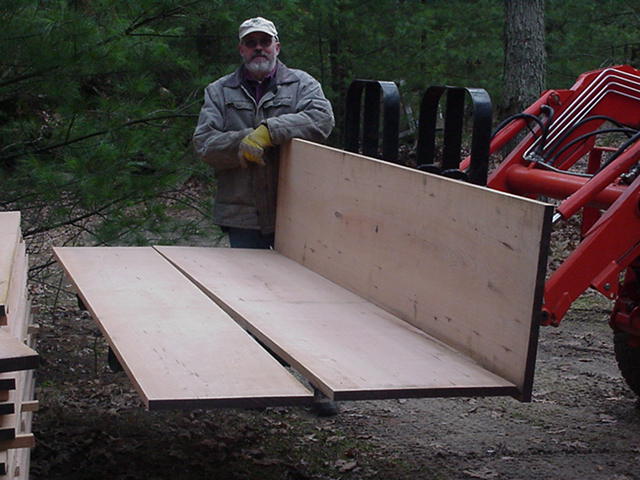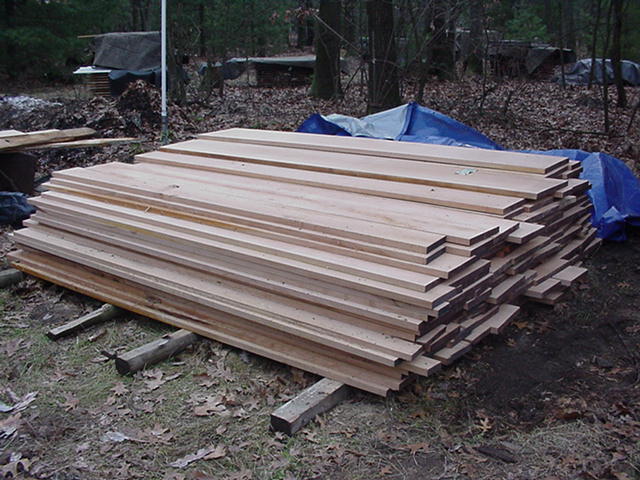Question
I have a cherry tree that was recently logged and is 24 inch diameter and 16 foot long with very little taper. I have plans to have it sawn and dried with a few projects in mind. What are the best dimensions to have it sawn, since I will not use all the wood for current projects?
Forum Responses
From Professor Gene Wengert, forum technical advisor:
I suggest 4/4 and 5/4. If you plan on making some legs, then 8/4 squares.
Second, quartersawn is slightly more stable *when the MC changes*. Quartersawn cherry will change about 0.12% in size for a 1% MC change for quartersawn and 0.24% for flatsawn. So with only annual MC changes of 3% MC in most of the USA, stability is not a big factor in most cases. Further, especially when we consider that flatsawn is often not true flatsawn (rings run perfectly parallel to the face) but also has some angled grain, this will reduce this 0.24 number; similarly q-sawn seldom has rings perfectly at 90 degrees to the face, which increases the 0.12 number. So, the difference in practice between q and f lumber is actually fairly small indeed.

Once again I agree with you completely that we are seldom blessed with perfectly processed, perfectly dried wood, trees are crooked, time is money, but a guy starting out with a raw log and a sawmill is in a great position to define that quality.
Using your math, quarter sawn lumber moves half as much as flat sawn. Given that lumber and finished furniture face an unknown future, wouldn't we benefit by starting with the best material we can find or process?
Having built a few pieces early in my wood processing career that either blew themselves up or moved with little provocation, I now opt to leave this board on the shelf. Once again I accept that personal preference is a ruling factor and respect your broad based knowledge, but is there really any debate about the comparative stability of flatsawn and quarter sawn lumber?
With the grain being better in flatsawn (which is most obvious after finishing) to many people, and the actual stability being not much different, I would suggest that flatsawn lumber is better, but that is an opinion and not a fact, as previously stated. But let's look at some more facts.
Perfectly flatsawn lumber moves twice as much as perfectly quartersawn in width, as previously stated. But we seldom will have perfectly flat or quarter grain, so the difference in practice is not that much. (Remember that we are talking about cherry lumber here. Some of the oaks have bigger differences, plus oaks and a few other species have ray flecks when q-sawing. Softwood stability is more uniform.)
When sawing quartersawn lumber, the yields drop by 15% or more, so although one may want it for stability, it is also wasteful. For that reason, often quartersawing is more accurately called riftsawn.
Quartersawn lumber also has knots that are spike knots rather than round or oval knots. Spike knots are not very pretty to look at. That is another reason not to quartersaw, but to get closer to riftsawing and riftsawn and flatsawn are very close in stability; so close that it is not worth considering.
Here is a more complete list of the differences which applies to all species when comparing perfectly flat to perfectly quarter:
Flatsawn shrinks and swells in thickness about half as much as quartersawn.
Quartersawn shrinks and swells in width about half as much as flatsawn. (This can be important for exterior siding that is subject to frequent wetting and drying. It can also be important for floors and other products that cannot tolerate much movement.)
Knots will be round or slightly oval with flatsawn, but will be long spike knots in quartersawn. (Generally, spike knots lower the strength more than round knots.)
Shake and pitch pockets in the log will affect fewer pieces when manufacturing flatsawn than when manufacturing quartersawn.
When manufacturing flatsawn lumber, the yield of lumber from a log can be several percent to as much as 20% higher than when manufacturing quartersawn.
Flatsawing requires less technical and mechanical effort than quartersawing.
Flatsawn lumber is prone to cupping in drying.
Quartersawn lumber is prone to sidebend in drying.
Quartersawn wears better when used as a flooring material than flatsawn.
Flatsawn lumber, especially oak, is subject to surface checking, honeycomb (interior checks) and splitting (especially end splits) in drying, while quartersawn is not.
Flatsawn lumber dries up to 15% faster than quartersawn.
Quartersawn lumber will accentuate other grain patterns such as wavy grain and interlocked grain.
This cherry grows right on the Lake Michigan shoreline. This wood came from a cherry tree that was approximately 110' tall according to the people who took it down. It was a 50/50 share cutting job, about 1500 board feet. I got 750 as my share. The 8.5' long logs were the same diameter at both ends. I've seen them growing out there on a cottage owner's site. He wanted me to take two of them down and cut them up. I could look up and not see the first limb on the tree before the trunk disappeared into the tree canopy from other trees. That would be as high as the top of a regular red oak tree where the trunk was still going up with no limbs. Just incredible cherry trees.
From Professor Gene Wengert, forum technical advisor:
What has not been stated is that quartersawn lumber moves twice as much in thickness as flatsawn. Thickness movement is also important, so this increased movement of quartersawn must also be considered when trying to say what is best. Therefore, one cannot accurately state that quartersawn cherry is best.
From contributor D:
Suggesting that the user's taste for the appearance of the wood could be the most important factor to consider when deciding on targeting either mostly flat or mostly quarter sawn wood from a cherry log. I think it is all beautiful, but the difference in appearance is substantial.
From contributor R:
I called a sawmill to check the prices of logs and as they were telling me the prices, she said they don't want any cherry. She said it's like poison now. So it looks like cherry has fallen out of favor.
From contributor K:
Q-sawn cherry is just, blah! Makes fine BBQ wood.
From contributor J:
Contributor T, where are you located? That looks like some sweeeet cherry!
From contributor T:
Muskegon, Michigan. If you like cherry, here's some more.

Click here for higher quality, full size image
Click here for higher quality, full size image